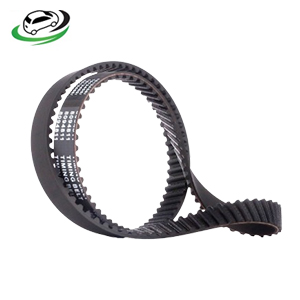-13%
Get Timing Belt 130 STP AUDI A2 2000-08 / VW Bora 1/Bora Variant/Caddy II/III/Golf IV/V/Lupo I/Polo/Polo III/Polo IV/Polo Variant 036109119AG
The timing belt is a crucial component of an internal combustion engine, playing a pivotal role in synchronizing the movement of the crankshaft and camshaft(s). This synchronization ensures that the engine’s valves open and close at the appropriate times during the engine’s cycle, which is vital for optimal performance and efficiency. Understanding the timing belt’s design, function, types, benefits, maintenance, and replacement is essential for any vehicle owner or automotive professional.
Design and Function
Design:
A timing belt is typically composed of the following elements:
- Belt Material: Most timing belts are made from a reinforced rubber or synthetic material, often with a fiber or steel cord reinforcement. This construction allows the belt to withstand high levels of stress and temperature.
- Teeth or Cogs: The inner surface of the timing belt has a series of teeth or cogs. These mesh with the gears on the camshaft and crankshaft to ensure precise timing.
- Belt Length: Timing belts are engineered to exact lengths to fit the specific engine design. Correct length ensures proper timing and alignment between the camshaft and crankshaft.
- Tensioners and Idlers: Timing belts require proper tension to function correctly. Tensioners and idler pulleys are used to maintain the correct tension and guide the belt along its path.
Function:
The primary functions of a timing belt include:
- Synchronizing Rotation: Ensures that the camshaft and crankshaft rotate in unison. This synchronization is critical for proper valve timing, which in turn affects engine performance and efficiency.
- Maintaining Timing: Regulates the timing of valve movements in relation to the piston positions, which is crucial for effective combustion and engine operation.
- Preventing Engine Damage: By keeping the camshaft and crankshaft in sync, the timing belt helps prevent potential engine damage that could result from misaligned valves.
Types of Timing Belts
1. Standard Timing Belts:
- Description: These are the most common type, typically made from rubber or synthetic material with a series of teeth. They are used in many standard engine applications.
- Advantages: Reliable and cost-effective for conventional engines.
2. High-Performance Timing Belts:
- Description: Designed for high-performance or racing engines, these belts are made from advanced materials such as Kevlar or reinforced composites.
- Advantages: Greater durability and strength, able to withstand high stress and temperatures, suitable for high-torque engines.
3. Silent Timing Belts:
- Description: Feature a design aimed at reducing noise during operation. They are often used in luxury or high-end vehicles to minimize engine noise.
- Advantages: Provides a quieter operation compared to standard timing belts, enhancing the driving experience.
4. Variable Valve Timing (VVT) Belts:
- Description: Used in engines with variable valve timing systems, these belts accommodate changes in valve timing for improved performance and fuel efficiency.
- Advantages: Allows for adjustments in valve timing based on engine conditions, optimizing both performance and efficiency.
Benefits
1. Engine Synchronization:
- Precise Timing: Ensures that the camshaft and crankshaft rotate in perfect harmony, which is critical for maintaining engine performance and avoiding misfires.
- Optimized Operation: Contributes to smooth engine operation and consistent power delivery.
2. Enhanced Performance:
- Power Output: Proper timing helps maximize power output and acceleration, contributing to overall engine performance.
- Fuel Efficiency: Accurate valve timing leads to more efficient fuel combustion, improving fuel economy.
3. Reduced Emissions:
- Cleaner Combustion: Proper timing ensures that the engine runs more efficiently, which helps to reduce harmful emissions and meet environmental standards.
4. Engine Protection:
- Prevents Damage: Helps to prevent damage caused by misaligned valves, which could otherwise result in severe engine problems or failure.
Maintenance and Troubleshooting
1. Regular Inspection:
- Check for Wear: Periodically inspect the timing belt for signs of wear, such as cracks, fraying, or glazing. Manufacturers generally recommend checking the belt every 60,000 to 100,000 miles, or according to the vehicle’s maintenance schedule.
- Monitor Tension: Ensure that the timing belt is properly tensioned. An overly tight or loose belt can lead to timing issues and potential engine damage.
2. Listen for Noise:
- Belt Noise: Pay attention to any unusual noises coming from the timing belt area, such as squealing or chirping. These noises may indicate a problem with the belt or its associated components.
3. Replacement:
- Signs of Failure: Replace the timing belt if you notice visible signs of damage, such as cracks or missing teeth, or if the belt has reached its recommended mileage interval.
- Replacement Procedure: Replacing a timing belt typically involves removing various engine components to access the belt. It’s crucial to follow the manufacturer’s instructions for proper installation and alignment. It’s often advisable to replace related components, such as tensioners and idlers, at the same time.
4. Timing Marks:
- Proper Alignment: After installing a new timing belt, ensure that the camshaft and crankshaft timing marks are correctly aligned. Incorrect alignment can lead to engine performance issues or damage.
Seasonal Considerations
1. Winter:
- Cold Weather: In colder climates, check the timing belt for signs of brittleness or cracking due to low temperatures. Ensure that the belt remains flexible and in good condition.
- Pre-Trip Inspection: Inspect the belt before winter driving to ensure it is ready for cold weather conditions.
2. Summer:
- Heat Exposure: In hot climates, check for signs of overheating or deterioration caused by high temperatures. Ensure that the timing belt is properly lubricated and not subject to excessive heat.
- Regular Checks: Inspect the belt for any signs of heat-related damage, such as warping or hardening.
Follow us on Facebook for more parts.



